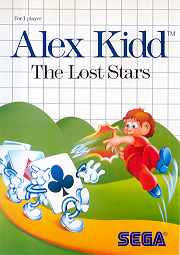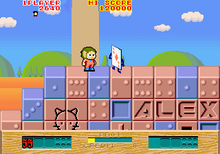Software:Alex Kidd: The Lost Stars
| Alex Kidd: The Lost Stars | |
|---|---|
 Western Master System box art | |
| Developer(s) | Sega |
| Publisher(s) | Sega |
| Composer(s) | Hiroshi Kawaguchi |
| Series | Alex Kidd |
| Platform(s) | Arcade, Master System |
| Release | December 10, 1986 (Arcade) March 10, 1988 (Master System) |
| Genre(s) | Platform |
| Mode(s) | Single-player, multiplayer |
| Arcade system | Sega System 16A |
Alex Kidd: The Lost Stars (アレックスキッド ザ・ロストスターズ Arekkusu Kiddo Za Rosuto Sutāzu) is a platform arcade game released by Sega on December 10, 1986. It was ported to the Master System on March 10, 1988. It was also released on the Wii Virtual Console in North America on March 9, 2009, and in the PAL regions on April 17, 2009.[1]
Plot
Alex Kidd: The Lost Stars features Alex Kidd and Stella searching for the twelve Zodiac signs. Alex's mission is to run through each level, knocking down enemies, and obtain the six miracle balls. These balls are hidden inside such unusual places as a Christmas present, the Fantasy Zone ship out of action, a pumpkin, a clamshell, a golden egg, and a desk bell. Levels include Toy World, Machine World, World of Make Believe, Water World, Monster World, and Giant's Body.
Once the six miracle balls are obtained, Alex must then venture in outer space to carry them to the holy land of Ziggurat. After the last level, the Shrine of Jiggarat, is complete, the player must run through all the levels again, but with new enemies. The player is under a time limit, and if the time expires, the player will lose a life.
The game is noteworthy for the scream Alex lets out whenever he gets hit, falls, or loses all his time.
Versions
The arcade and Master System versions are similar, aside from graphics and sound. The arcade version has a limited number of lives (three by default), whereas the Master System version has infinite lives, though being hit or falling into a pit subtracts seconds in the timer and backtracks the player to the last checkpoint in the round. The arcade version features a cooperative two-player mode, with the second player assuming the control of a female counterpart to Alex Kidd named Stella.
Reception
In Japan, Game Machine listed Alex Kidd: The Lost Stars on their February 1, 1988 issue as being the thirteenth most-successful table arcade unit of the month.[2]
Computer and Video Games reviewed the Sega Master System version in 1990, giving it an 80% score. The magazine praised the "jolly and colourful" graphics and said "the gameplay is as addictive as all the others in the series."[3]
Retrospectively, Lucas Thomas IGN rated the Virtual Console release 5 out of 10. He stated that it "lost almost all of the momentum built up" by Alex Kidd in Miracle World and "did away with many of the mechanics that made Miracle World memorable, like the different rideable vehicles" and the ability to punch.[4]
References
- ↑ "One WiiWare Game and One Virtual Console Game Added to Wii Shop Channel". Nintendo of America. 2009-03-09. https://www.nintendo.com/whatsnew/detail/kGnfEnC8ZpLtQcyk4rlcm5pm99qFQ7ld. Retrieved 2009-03-09.
- ↑ "Game Machine's Best Hit Games 25 - テーブル型TVゲーム機 (Table Videos)". Game Machine (Amusement Press, Inc.) (301): 21. 1 February 1988.
- ↑ "Guide: Sega". Computer and Video Games (Complete Guide to Consoles: Volume IV): 89–110. November 1990. https://archive.org/details/Complete_Guide_to_Consoles_Volume_IV_1990_EMAP_Publishing_GB/page/n88.
- ↑ Thomas, Lucas (May 12, 2012). "Alex Kidd: The Lost Stars Review". https://www.ign.com/articles/2009/03/09/alex-kidd-the-lost-stars-review.
External links
- Alex Kidd: The Lost Stars at the Killer List of Videogames
- Alex Kidd: The Lost Stars at MobyGames
- Alex Kidd: The Lost Stars at Arcade-History
- Alex Kidd: The Lost Stars at Hardcore Gaming 101
 |


